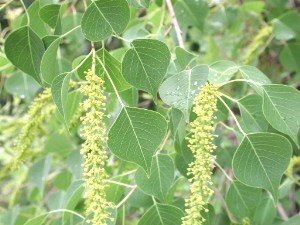Asia-Temperate:
China: China - Anhui, - Fujian, - Gansu, - Guangdong, - Guangxi, - Guizhou, - Hainan, - Hubei, - Jiangsu, - Jiangxi, - Shaanxi, - Shandong, - Sichuan, - Yunnan, - Zhejiang
Eastern Asia: Taiwan
Asia-Tropical:
Indo-China: Vietnam
Trees, to 13 m (fertile from 1 m). Leaves: stipules persistent, elliptic, 0.7–1 × 0.5–0.7 mm; petiole 2–7 cm, glands 2, discoid, adaxial; blade ovate to broadly elliptic or rhomboid, 3.5–10 × 3–9.5 cm, base broadly cuneate to nearly truncate, apex acuminate; laminar glands 0–10, elliptic, 0.3 × 0.2 mm, usually on distal 1/2 of leaf. Inflorescences to 20 cm; staminate cymules numerous, 10–20 flowered, bracts ovate, 1.5 mm, subtended by 2[–4] ellipsoid glands; pistillate flowers 0–6 per inflorescence, 1 per bract (often in bisexual cymules with 0–5 staminate flowers), bracts of basal flowers usually not subtended by ellipsoid glands. Pedicels: staminate 1.5–3 mm; pistillate 1–2 mm, to 12 mm in fruit. Staminate flowers yellow; sepals 0.5–1 mm, shallowly 3-lobed, margins erose; filaments to 0.2–0.3 mm; anthers 0.5 mm. Pistillate flowers yellowish green; sepals 2–3 × 1 mm, apex acuminate; styles 4–8 mm, coiled distally. Capsules 1–1.3 cm diam., subglobose, trigonous; columella 1 cm. Seeds 6–9 × 4–7 mm, usually remaining attached to columella; outer seed coat white, waxy; inner coat woody, brown, smooth. 2n = 88.
Chinese tallowtree is native to China and Japan. It was introduced into the United States in the 1700?s in South Carolina. It was distributed in the Gulf Coast in the 1900?s by the U.S. Department of Agriculture in an attempt to establish a soap making industry.
